Kaplan Business School: FINM4000 Finance Assessment 2 Report
VerifiedAdded on 2022/11/14
|10
|2083
|276
Report
AI Summary
This report analyzes Apple Inc.'s financial performance, focusing on working capital efficiency, risk assessment, and capital budgeting decisions. The analysis begins with an evaluation of Apple's working capital efficiency, comparing its performance to competitors and examining key financial ratios such as inventory turnover, days of sales outstanding, and cash conversion cycle. The report then identifies major risks faced by Apple, including both systematic and unsystematic risks. The analysis extends to Apple's share price performance and long-term debt, including a calculation of bond price and holding period return. The capital budgeting section evaluates the feasibility of a new Apple store, calculating free cash flows, net present value (NPV) at different weighted average cost of capital (WACC) rates, and internal rate of return (IRR). Based on the overall assessment, a decision regarding the new store is recommended. The report utilizes data from Apple's annual reports and other financial sources to support its conclusions. Excel spreadsheets are attached for detailed calculations.
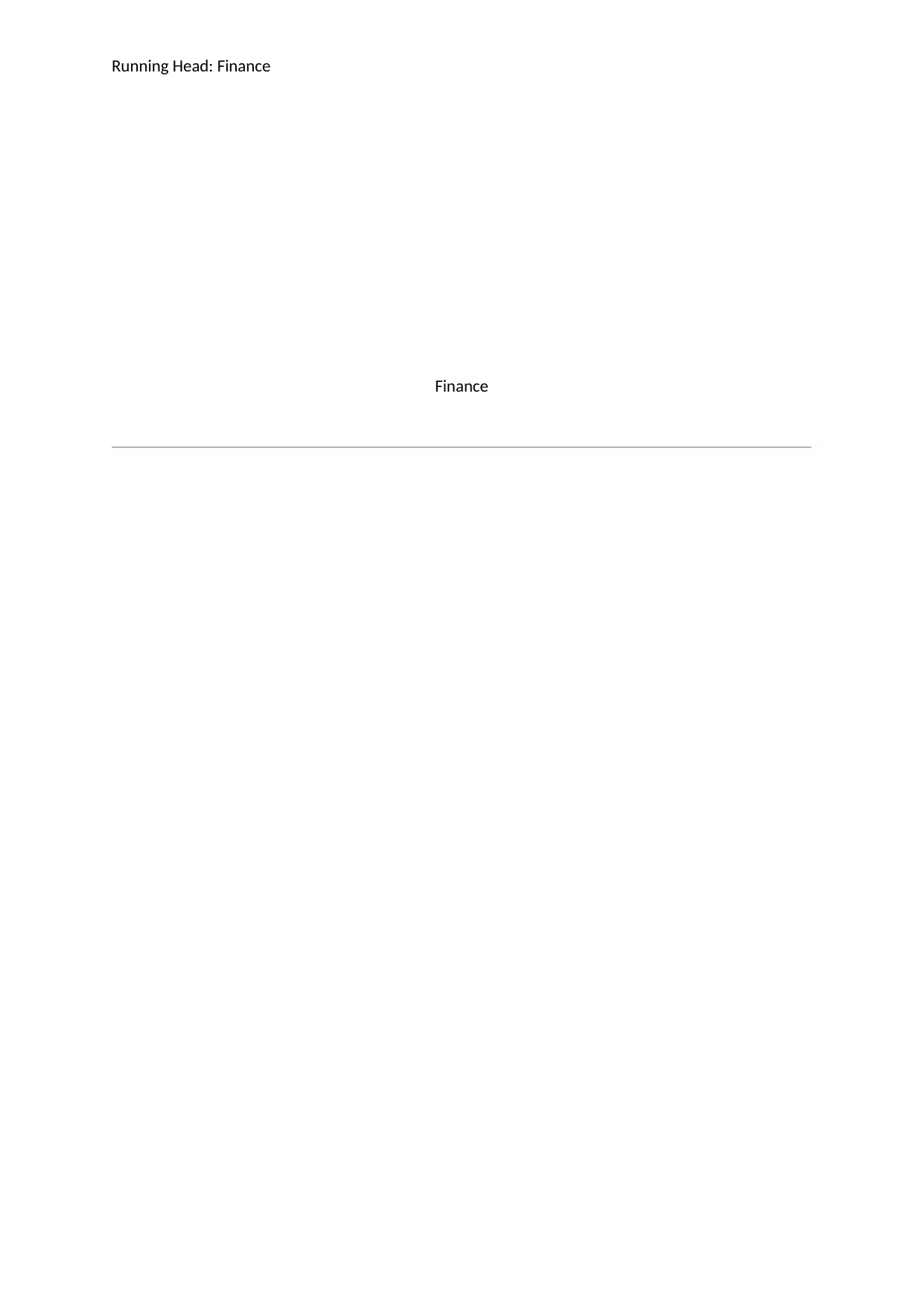
Running Head: Finance
Finance
Finance
Paraphrase This Document
Need a fresh take? Get an instant paraphrase of this document with our AI Paraphraser
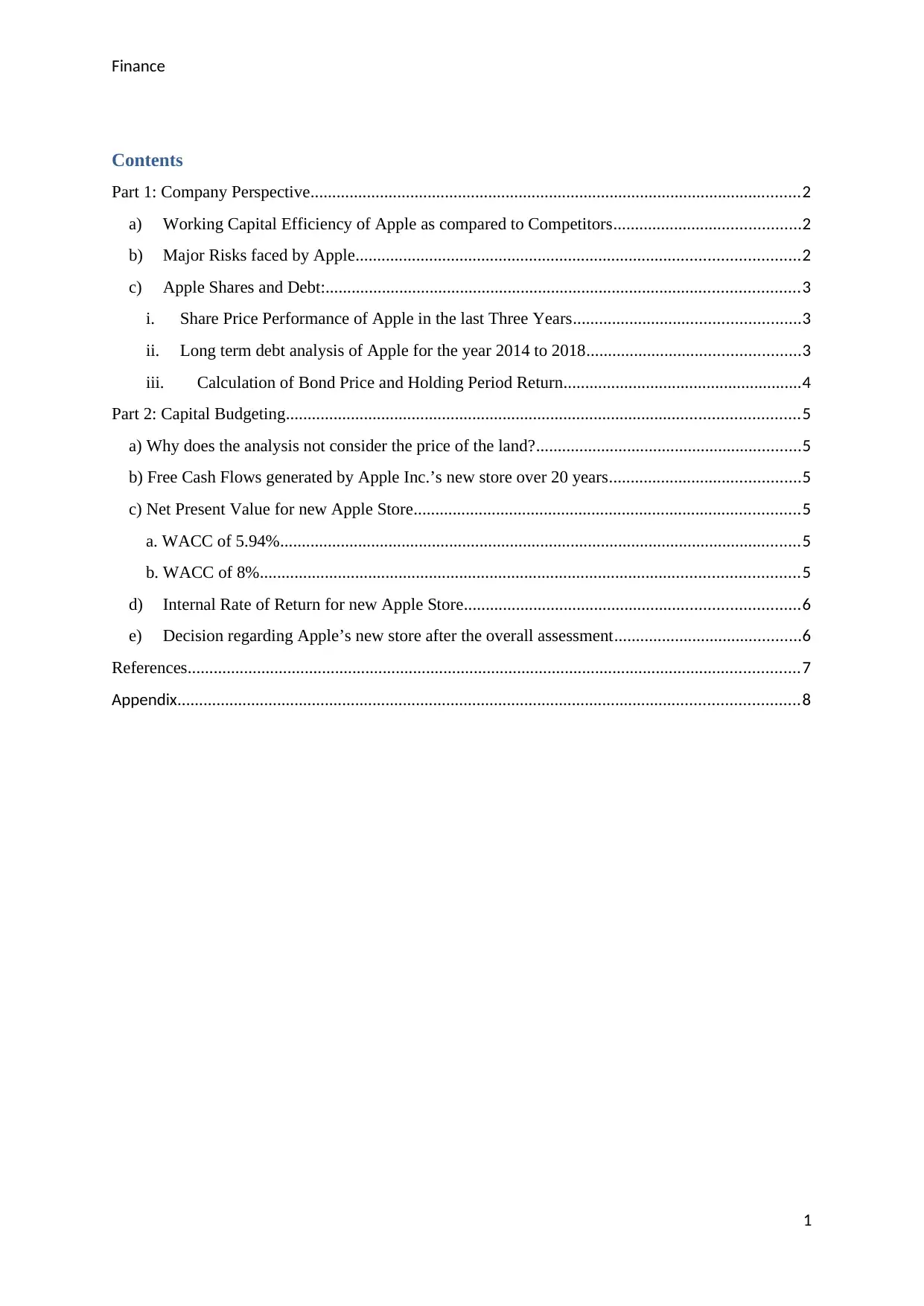
Finance
Contents
Part 1: Company Perspective.................................................................................................................2
a) Working Capital Efficiency of Apple as compared to Competitors...........................................2
b) Major Risks faced by Apple......................................................................................................2
c) Apple Shares and Debt:.............................................................................................................3
i. Share Price Performance of Apple in the last Three Years....................................................3
ii. Long term debt analysis of Apple for the year 2014 to 2018.................................................3
iii. Calculation of Bond Price and Holding Period Return.......................................................4
Part 2: Capital Budgeting......................................................................................................................5
a) Why does the analysis not consider the price of the land?.............................................................5
b) Free Cash Flows generated by Apple Inc.’s new store over 20 years............................................5
c) Net Present Value for new Apple Store.........................................................................................5
a. WACC of 5.94%........................................................................................................................5
b. WACC of 8%............................................................................................................................5
d) Internal Rate of Return for new Apple Store.............................................................................6
e) Decision regarding Apple’s new store after the overall assessment...........................................6
References.............................................................................................................................................7
Appendix...............................................................................................................................................8
1
Contents
Part 1: Company Perspective.................................................................................................................2
a) Working Capital Efficiency of Apple as compared to Competitors...........................................2
b) Major Risks faced by Apple......................................................................................................2
c) Apple Shares and Debt:.............................................................................................................3
i. Share Price Performance of Apple in the last Three Years....................................................3
ii. Long term debt analysis of Apple for the year 2014 to 2018.................................................3
iii. Calculation of Bond Price and Holding Period Return.......................................................4
Part 2: Capital Budgeting......................................................................................................................5
a) Why does the analysis not consider the price of the land?.............................................................5
b) Free Cash Flows generated by Apple Inc.’s new store over 20 years............................................5
c) Net Present Value for new Apple Store.........................................................................................5
a. WACC of 5.94%........................................................................................................................5
b. WACC of 8%............................................................................................................................5
d) Internal Rate of Return for new Apple Store.............................................................................6
e) Decision regarding Apple’s new store after the overall assessment...........................................6
References.............................................................................................................................................7
Appendix...............................................................................................................................................8
1
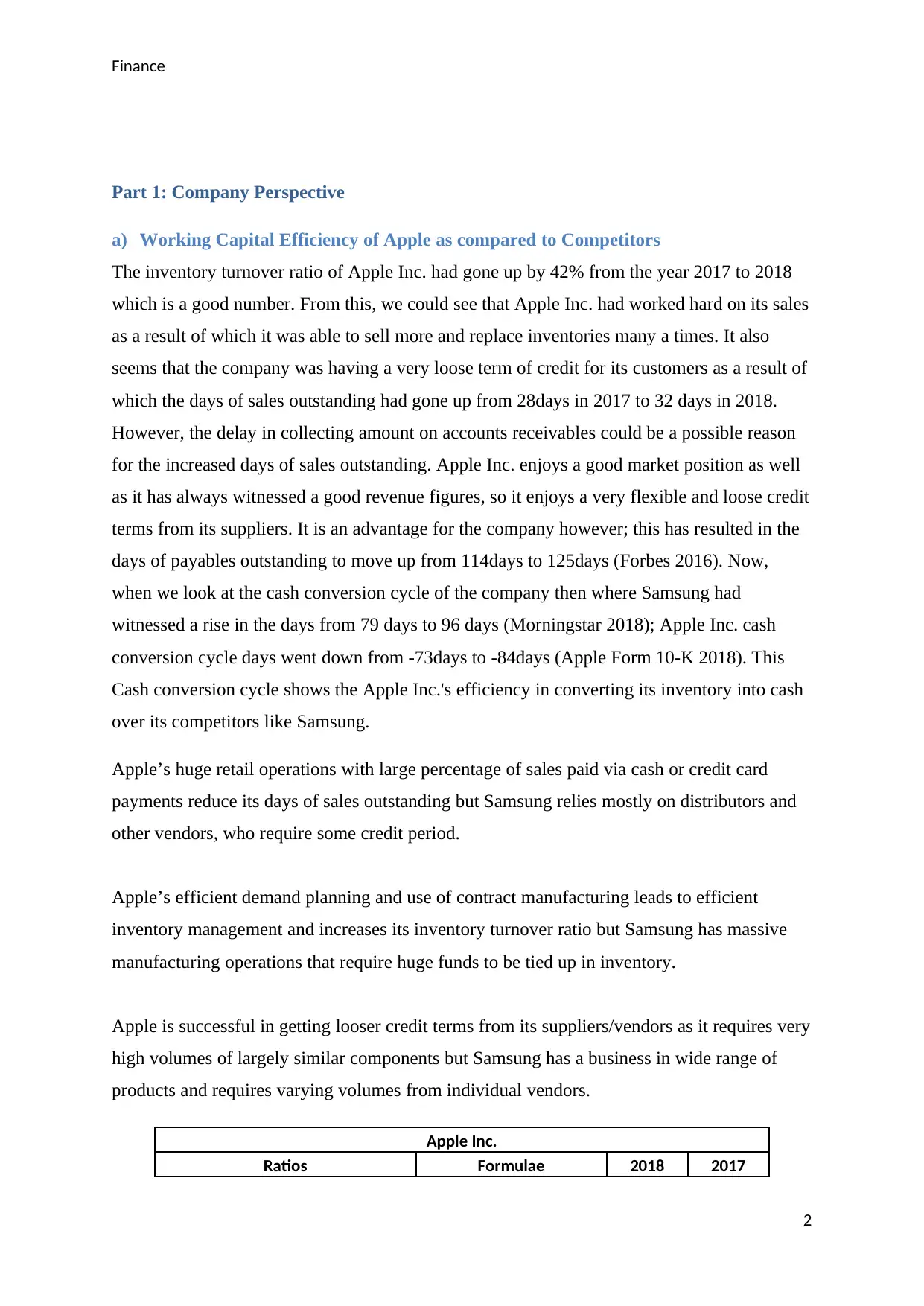
Finance
Part 1: Company Perspective
a) Working Capital Efficiency of Apple as compared to Competitors
The inventory turnover ratio of Apple Inc. had gone up by 42% from the year 2017 to 2018
which is a good number. From this, we could see that Apple Inc. had worked hard on its sales
as a result of which it was able to sell more and replace inventories many a times. It also
seems that the company was having a very loose term of credit for its customers as a result of
which the days of sales outstanding had gone up from 28days in 2017 to 32 days in 2018.
However, the delay in collecting amount on accounts receivables could be a possible reason
for the increased days of sales outstanding. Apple Inc. enjoys a good market position as well
as it has always witnessed a good revenue figures, so it enjoys a very flexible and loose credit
terms from its suppliers. It is an advantage for the company however; this has resulted in the
days of payables outstanding to move up from 114days to 125days (Forbes 2016). Now,
when we look at the cash conversion cycle of the company then where Samsung had
witnessed a rise in the days from 79 days to 96 days (Morningstar 2018); Apple Inc. cash
conversion cycle days went down from -73days to -84days (Apple Form 10-K 2018). This
Cash conversion cycle shows the Apple Inc.'s efficiency in converting its inventory into cash
over its competitors like Samsung.
Apple’s huge retail operations with large percentage of sales paid via cash or credit card
payments reduce its days of sales outstanding but Samsung relies mostly on distributors and
other vendors, who require some credit period.
Apple’s efficient demand planning and use of contract manufacturing leads to efficient
inventory management and increases its inventory turnover ratio but Samsung has massive
manufacturing operations that require huge funds to be tied up in inventory.
Apple is successful in getting looser credit terms from its suppliers/vendors as it requires very
high volumes of largely similar components but Samsung has a business in wide range of
products and requires varying volumes from individual vendors.
Apple Inc.
Ratios Formulae 2018 2017
2
Part 1: Company Perspective
a) Working Capital Efficiency of Apple as compared to Competitors
The inventory turnover ratio of Apple Inc. had gone up by 42% from the year 2017 to 2018
which is a good number. From this, we could see that Apple Inc. had worked hard on its sales
as a result of which it was able to sell more and replace inventories many a times. It also
seems that the company was having a very loose term of credit for its customers as a result of
which the days of sales outstanding had gone up from 28days in 2017 to 32 days in 2018.
However, the delay in collecting amount on accounts receivables could be a possible reason
for the increased days of sales outstanding. Apple Inc. enjoys a good market position as well
as it has always witnessed a good revenue figures, so it enjoys a very flexible and loose credit
terms from its suppliers. It is an advantage for the company however; this has resulted in the
days of payables outstanding to move up from 114days to 125days (Forbes 2016). Now,
when we look at the cash conversion cycle of the company then where Samsung had
witnessed a rise in the days from 79 days to 96 days (Morningstar 2018); Apple Inc. cash
conversion cycle days went down from -73days to -84days (Apple Form 10-K 2018). This
Cash conversion cycle shows the Apple Inc.'s efficiency in converting its inventory into cash
over its competitors like Samsung.
Apple’s huge retail operations with large percentage of sales paid via cash or credit card
payments reduce its days of sales outstanding but Samsung relies mostly on distributors and
other vendors, who require some credit period.
Apple’s efficient demand planning and use of contract manufacturing leads to efficient
inventory management and increases its inventory turnover ratio but Samsung has massive
manufacturing operations that require huge funds to be tied up in inventory.
Apple is successful in getting looser credit terms from its suppliers/vendors as it requires very
high volumes of largely similar components but Samsung has a business in wide range of
products and requires varying volumes from individual vendors.
Apple Inc.
Ratios Formulae 2018 2017
2
⊘ This is a preview!⊘
Do you want full access?
Subscribe today to unlock all pages.

Trusted by 1+ million students worldwide
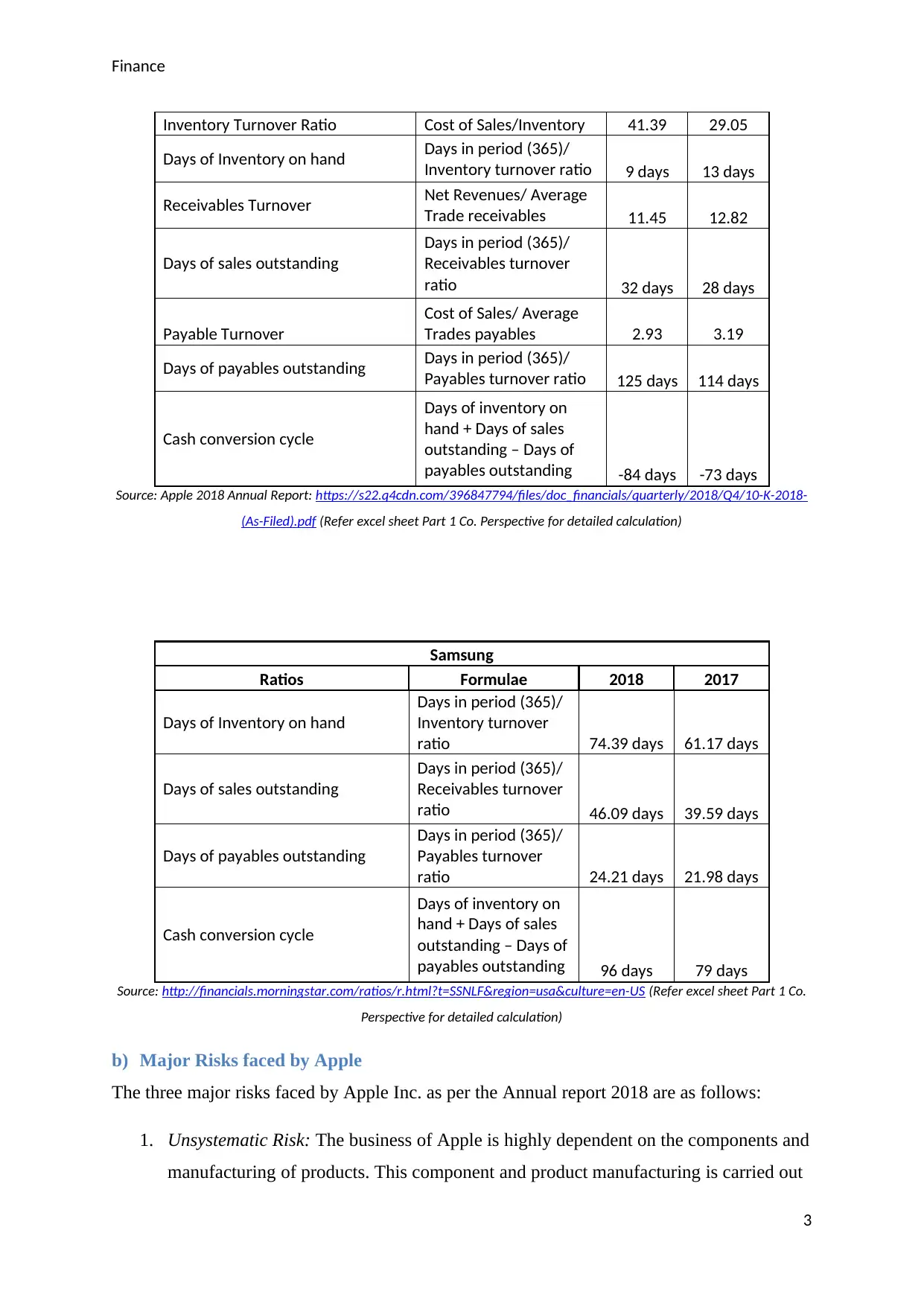
Finance
Inventory Turnover Ratio Cost of Sales/Inventory 41.39 29.05
Days of Inventory on hand Days in period (365)/
Inventory turnover ratio 9 days 13 days
Receivables Turnover Net Revenues/ Average
Trade receivables 11.45 12.82
Days of sales outstanding
Days in period (365)/
Receivables turnover
ratio 32 days 28 days
Payable Turnover
Cost of Sales/ Average
Trades payables 2.93 3.19
Days of payables outstanding Days in period (365)/
Payables turnover ratio 125 days 114 days
Cash conversion cycle
Days of inventory on
hand + Days of sales
outstanding – Days of
payables outstanding -84 days -73 days
Source: Apple 2018 Annual Report: https://s22.q4cdn.com/396847794/files/doc_financials/quarterly/2018/Q4/10-K-2018-
(As-Filed).pdf (Refer excel sheet Part 1 Co. Perspective for detailed calculation)
Samsung
Ratios Formulae 2018 2017
Days of Inventory on hand
Days in period (365)/
Inventory turnover
ratio 74.39 days 61.17 days
Days of sales outstanding
Days in period (365)/
Receivables turnover
ratio 46.09 days 39.59 days
Days of payables outstanding
Days in period (365)/
Payables turnover
ratio 24.21 days 21.98 days
Cash conversion cycle
Days of inventory on
hand + Days of sales
outstanding – Days of
payables outstanding 96 days 79 days
Source: http://financials.morningstar.com/ratios/r.html?t=SSNLF®ion=usa&culture=en-US (Refer excel sheet Part 1 Co.
Perspective for detailed calculation)
b) Major Risks faced by Apple
The three major risks faced by Apple Inc. as per the Annual report 2018 are as follows:
1. Unsystematic Risk: The business of Apple is highly dependent on the components and
manufacturing of products. This component and product manufacturing is carried out
3
Inventory Turnover Ratio Cost of Sales/Inventory 41.39 29.05
Days of Inventory on hand Days in period (365)/
Inventory turnover ratio 9 days 13 days
Receivables Turnover Net Revenues/ Average
Trade receivables 11.45 12.82
Days of sales outstanding
Days in period (365)/
Receivables turnover
ratio 32 days 28 days
Payable Turnover
Cost of Sales/ Average
Trades payables 2.93 3.19
Days of payables outstanding Days in period (365)/
Payables turnover ratio 125 days 114 days
Cash conversion cycle
Days of inventory on
hand + Days of sales
outstanding – Days of
payables outstanding -84 days -73 days
Source: Apple 2018 Annual Report: https://s22.q4cdn.com/396847794/files/doc_financials/quarterly/2018/Q4/10-K-2018-
(As-Filed).pdf (Refer excel sheet Part 1 Co. Perspective for detailed calculation)
Samsung
Ratios Formulae 2018 2017
Days of Inventory on hand
Days in period (365)/
Inventory turnover
ratio 74.39 days 61.17 days
Days of sales outstanding
Days in period (365)/
Receivables turnover
ratio 46.09 days 39.59 days
Days of payables outstanding
Days in period (365)/
Payables turnover
ratio 24.21 days 21.98 days
Cash conversion cycle
Days of inventory on
hand + Days of sales
outstanding – Days of
payables outstanding 96 days 79 days
Source: http://financials.morningstar.com/ratios/r.html?t=SSNLF®ion=usa&culture=en-US (Refer excel sheet Part 1 Co.
Perspective for detailed calculation)
b) Major Risks faced by Apple
The three major risks faced by Apple Inc. as per the Annual report 2018 are as follows:
1. Unsystematic Risk: The business of Apple is highly dependent on the components and
manufacturing of products. This component and product manufacturing is carried out
3
Paraphrase This Document
Need a fresh take? Get an instant paraphrase of this document with our AI Paraphraser
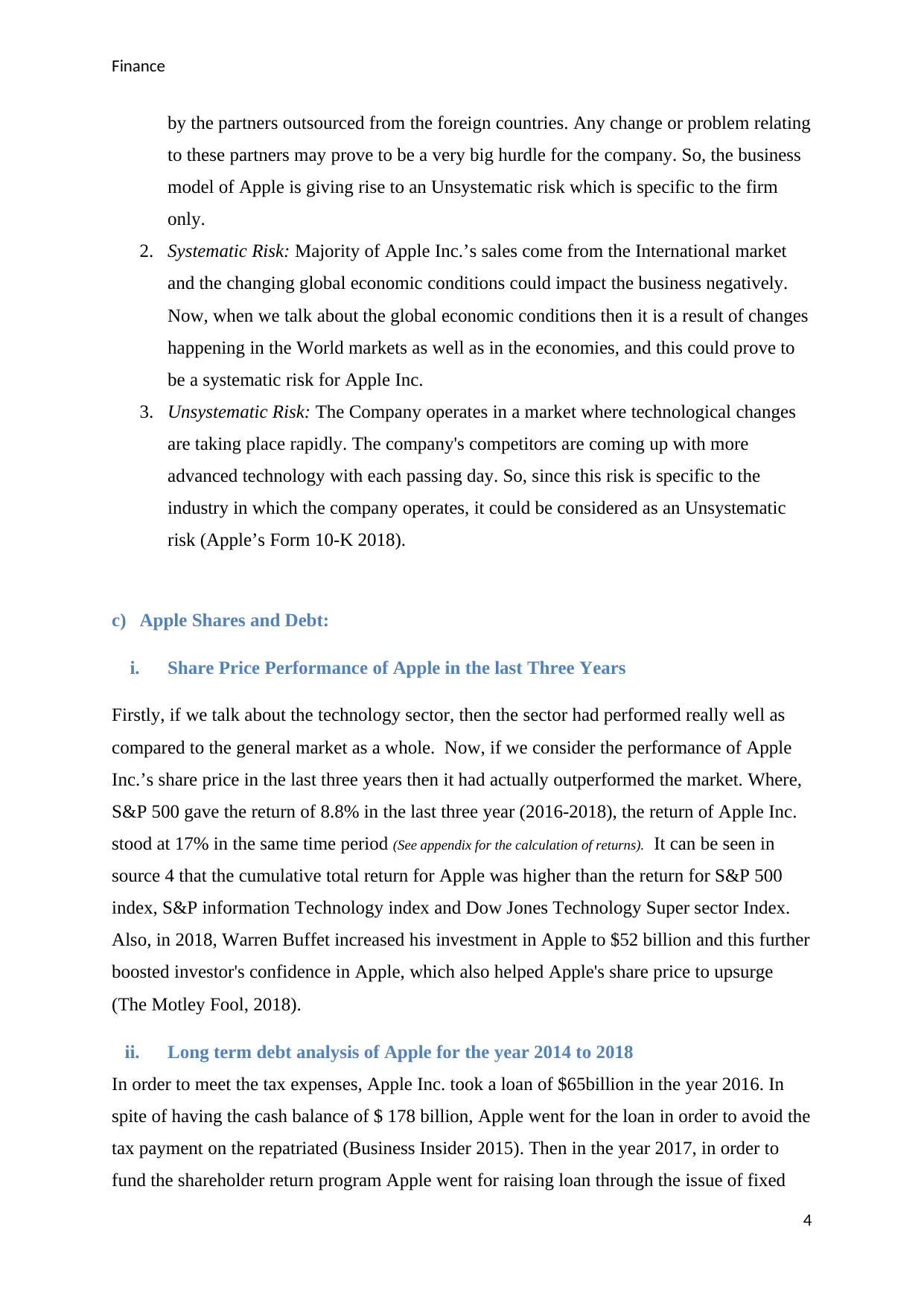
Finance
by the partners outsourced from the foreign countries. Any change or problem relating
to these partners may prove to be a very big hurdle for the company. So, the business
model of Apple is giving rise to an Unsystematic risk which is specific to the firm
only.
2. Systematic Risk: Majority of Apple Inc.’s sales come from the International market
and the changing global economic conditions could impact the business negatively.
Now, when we talk about the global economic conditions then it is a result of changes
happening in the World markets as well as in the economies, and this could prove to
be a systematic risk for Apple Inc.
3. Unsystematic Risk: The Company operates in a market where technological changes
are taking place rapidly. The company's competitors are coming up with more
advanced technology with each passing day. So, since this risk is specific to the
industry in which the company operates, it could be considered as an Unsystematic
risk (Apple’s Form 10-K 2018).
c) Apple Shares and Debt:
i. Share Price Performance of Apple in the last Three Years
Firstly, if we talk about the technology sector, then the sector had performed really well as
compared to the general market as a whole. Now, if we consider the performance of Apple
Inc.’s share price in the last three years then it had actually outperformed the market. Where,
S&P 500 gave the return of 8.8% in the last three year (2016-2018), the return of Apple Inc.
stood at 17% in the same time period (See appendix for the calculation of returns). It can be seen in
source 4 that the cumulative total return for Apple was higher than the return for S&P 500
index, S&P information Technology index and Dow Jones Technology Super sector Index.
Also, in 2018, Warren Buffet increased his investment in Apple to $52 billion and this further
boosted investor's confidence in Apple, which also helped Apple's share price to upsurge
(The Motley Fool, 2018).
ii. Long term debt analysis of Apple for the year 2014 to 2018
In order to meet the tax expenses, Apple Inc. took a loan of $65billion in the year 2016. In
spite of having the cash balance of $ 178 billion, Apple went for the loan in order to avoid the
tax payment on the repatriated (Business Insider 2015). Then in the year 2017, in order to
fund the shareholder return program Apple went for raising loan through the issue of fixed
4
by the partners outsourced from the foreign countries. Any change or problem relating
to these partners may prove to be a very big hurdle for the company. So, the business
model of Apple is giving rise to an Unsystematic risk which is specific to the firm
only.
2. Systematic Risk: Majority of Apple Inc.’s sales come from the International market
and the changing global economic conditions could impact the business negatively.
Now, when we talk about the global economic conditions then it is a result of changes
happening in the World markets as well as in the economies, and this could prove to
be a systematic risk for Apple Inc.
3. Unsystematic Risk: The Company operates in a market where technological changes
are taking place rapidly. The company's competitors are coming up with more
advanced technology with each passing day. So, since this risk is specific to the
industry in which the company operates, it could be considered as an Unsystematic
risk (Apple’s Form 10-K 2018).
c) Apple Shares and Debt:
i. Share Price Performance of Apple in the last Three Years
Firstly, if we talk about the technology sector, then the sector had performed really well as
compared to the general market as a whole. Now, if we consider the performance of Apple
Inc.’s share price in the last three years then it had actually outperformed the market. Where,
S&P 500 gave the return of 8.8% in the last three year (2016-2018), the return of Apple Inc.
stood at 17% in the same time period (See appendix for the calculation of returns). It can be seen in
source 4 that the cumulative total return for Apple was higher than the return for S&P 500
index, S&P information Technology index and Dow Jones Technology Super sector Index.
Also, in 2018, Warren Buffet increased his investment in Apple to $52 billion and this further
boosted investor's confidence in Apple, which also helped Apple's share price to upsurge
(The Motley Fool, 2018).
ii. Long term debt analysis of Apple for the year 2014 to 2018
In order to meet the tax expenses, Apple Inc. took a loan of $65billion in the year 2016. In
spite of having the cash balance of $ 178 billion, Apple went for the loan in order to avoid the
tax payment on the repatriated (Business Insider 2015). Then in the year 2017, in order to
fund the shareholder return program Apple went for raising loan through the issue of fixed
4

Finance
and floating rate notes,5-year notes, 10-year notes and a 30-year bond (Yahoo Finance 2018).
From the figure “A” we could see how long term debt of apple had increased over the years
(Seeking Alpha 2017).
Figure “A”: Apple Inc.’s Total Debt and Interest Expense
Source: Seeking Alpha, 2017 (https://seekingalpha.com/article/4083517-apple-debt-binge)
5
and floating rate notes,5-year notes, 10-year notes and a 30-year bond (Yahoo Finance 2018).
From the figure “A” we could see how long term debt of apple had increased over the years
(Seeking Alpha 2017).
Figure “A”: Apple Inc.’s Total Debt and Interest Expense
Source: Seeking Alpha, 2017 (https://seekingalpha.com/article/4083517-apple-debt-binge)
5
⊘ This is a preview!⊘
Do you want full access?
Subscribe today to unlock all pages.

Trusted by 1+ million students worldwide
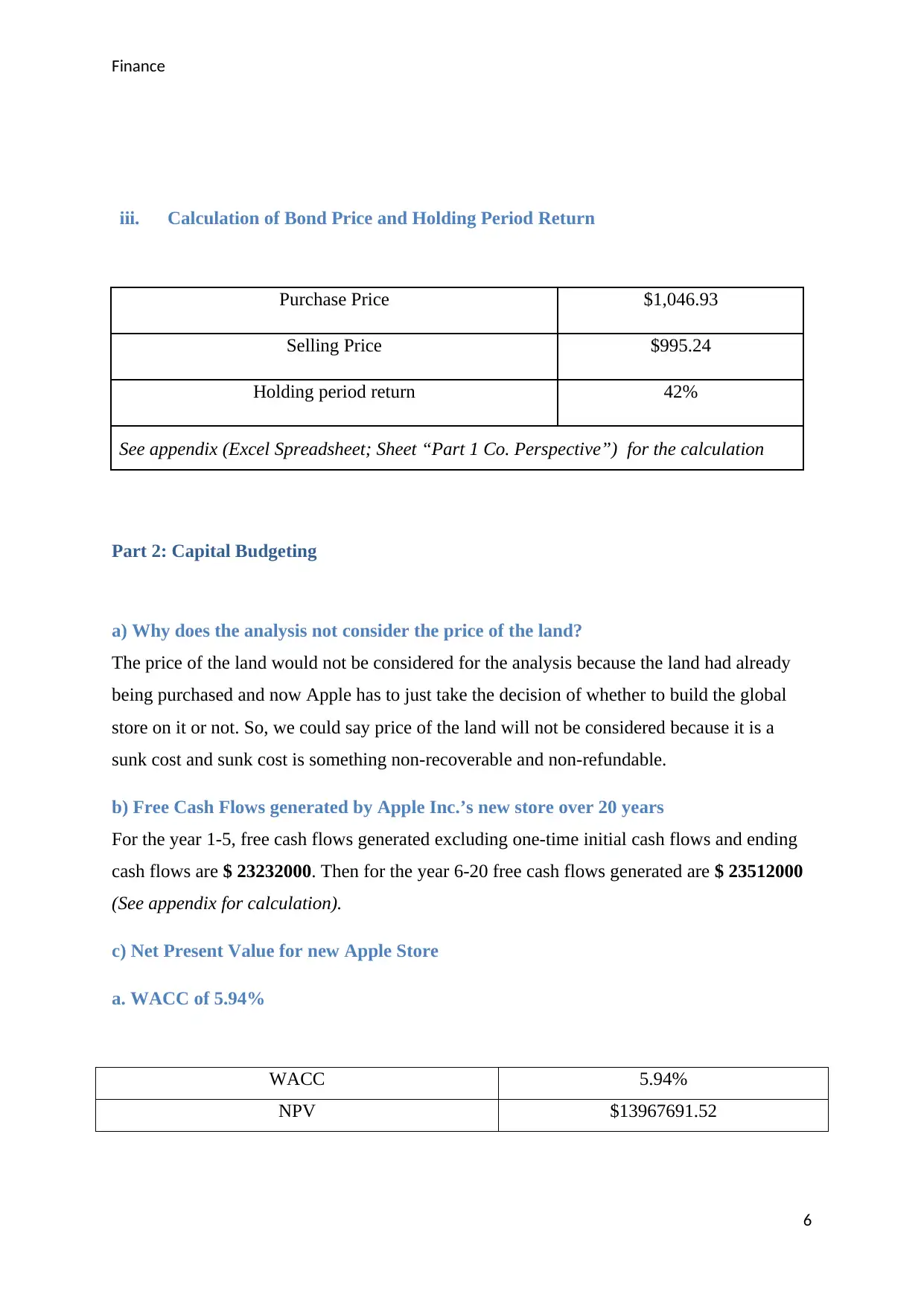
Finance
iii. Calculation of Bond Price and Holding Period Return
Purchase Price $1,046.93
Selling Price $995.24
Holding period return 42%
See appendix (Excel Spreadsheet; Sheet “Part 1 Co. Perspective”) for the calculation
Part 2: Capital Budgeting
a) Why does the analysis not consider the price of the land?
The price of the land would not be considered for the analysis because the land had already
being purchased and now Apple has to just take the decision of whether to build the global
store on it or not. So, we could say price of the land will not be considered because it is a
sunk cost and sunk cost is something non-recoverable and non-refundable.
b) Free Cash Flows generated by Apple Inc.’s new store over 20 years
For the year 1-5, free cash flows generated excluding one-time initial cash flows and ending
cash flows are $ 23232000. Then for the year 6-20 free cash flows generated are $ 23512000
(See appendix for calculation).
c) Net Present Value for new Apple Store
a. WACC of 5.94%
WACC 5.94%
NPV $13967691.52
6
iii. Calculation of Bond Price and Holding Period Return
Purchase Price $1,046.93
Selling Price $995.24
Holding period return 42%
See appendix (Excel Spreadsheet; Sheet “Part 1 Co. Perspective”) for the calculation
Part 2: Capital Budgeting
a) Why does the analysis not consider the price of the land?
The price of the land would not be considered for the analysis because the land had already
being purchased and now Apple has to just take the decision of whether to build the global
store on it or not. So, we could say price of the land will not be considered because it is a
sunk cost and sunk cost is something non-recoverable and non-refundable.
b) Free Cash Flows generated by Apple Inc.’s new store over 20 years
For the year 1-5, free cash flows generated excluding one-time initial cash flows and ending
cash flows are $ 23232000. Then for the year 6-20 free cash flows generated are $ 23512000
(See appendix for calculation).
c) Net Present Value for new Apple Store
a. WACC of 5.94%
WACC 5.94%
NPV $13967691.52
6
Paraphrase This Document
Need a fresh take? Get an instant paraphrase of this document with our AI Paraphraser
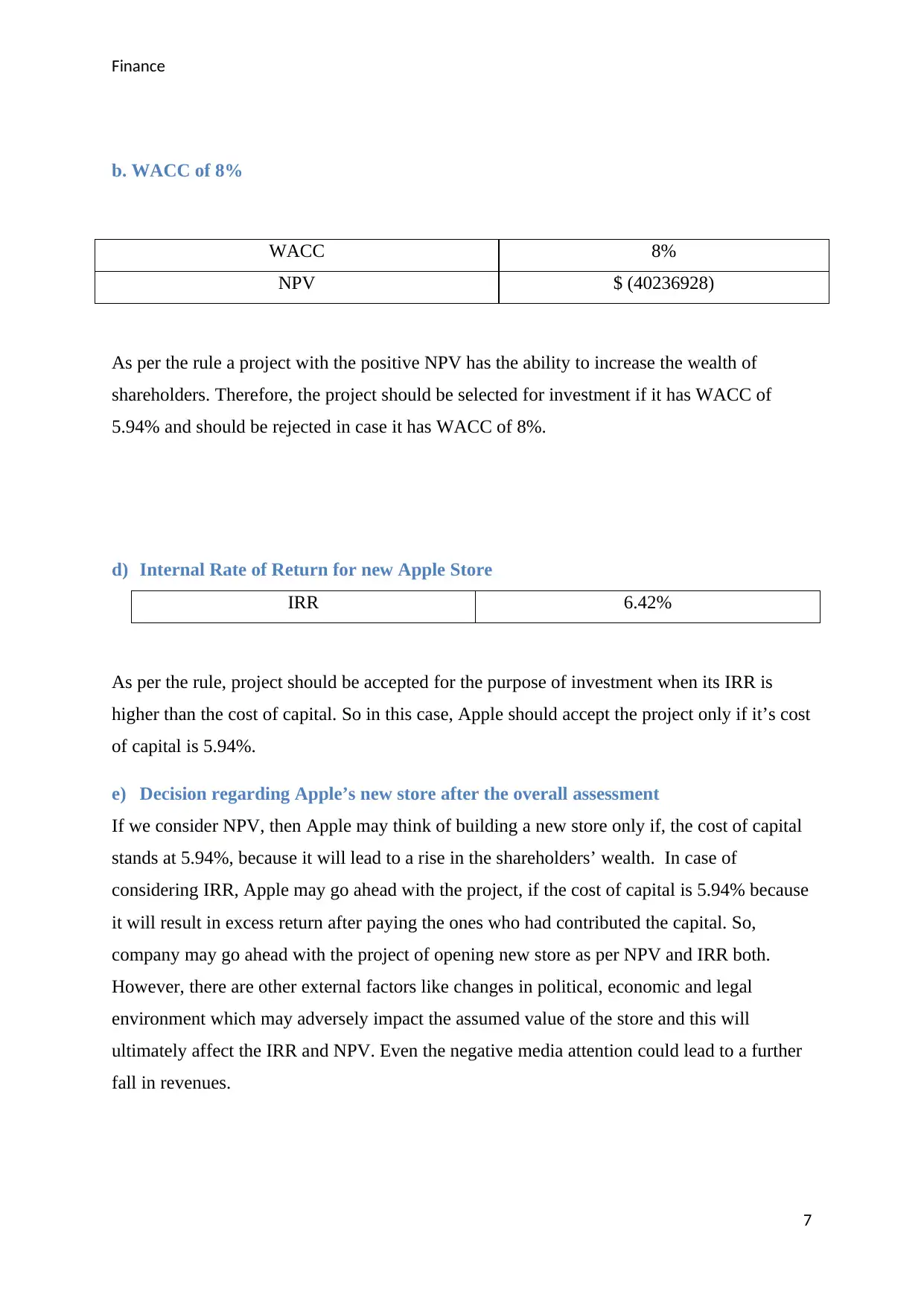
Finance
b. WACC of 8%
WACC 8%
NPV $ (40236928)
As per the rule a project with the positive NPV has the ability to increase the wealth of
shareholders. Therefore, the project should be selected for investment if it has WACC of
5.94% and should be rejected in case it has WACC of 8%.
d) Internal Rate of Return for new Apple Store
IRR 6.42%
As per the rule, project should be accepted for the purpose of investment when its IRR is
higher than the cost of capital. So in this case, Apple should accept the project only if it’s cost
of capital is 5.94%.
e) Decision regarding Apple’s new store after the overall assessment
If we consider NPV, then Apple may think of building a new store only if, the cost of capital
stands at 5.94%, because it will lead to a rise in the shareholders’ wealth. In case of
considering IRR, Apple may go ahead with the project, if the cost of capital is 5.94% because
it will result in excess return after paying the ones who had contributed the capital. So,
company may go ahead with the project of opening new store as per NPV and IRR both.
However, there are other external factors like changes in political, economic and legal
environment which may adversely impact the assumed value of the store and this will
ultimately affect the IRR and NPV. Even the negative media attention could lead to a further
fall in revenues.
7
b. WACC of 8%
WACC 8%
NPV $ (40236928)
As per the rule a project with the positive NPV has the ability to increase the wealth of
shareholders. Therefore, the project should be selected for investment if it has WACC of
5.94% and should be rejected in case it has WACC of 8%.
d) Internal Rate of Return for new Apple Store
IRR 6.42%
As per the rule, project should be accepted for the purpose of investment when its IRR is
higher than the cost of capital. So in this case, Apple should accept the project only if it’s cost
of capital is 5.94%.
e) Decision regarding Apple’s new store after the overall assessment
If we consider NPV, then Apple may think of building a new store only if, the cost of capital
stands at 5.94%, because it will lead to a rise in the shareholders’ wealth. In case of
considering IRR, Apple may go ahead with the project, if the cost of capital is 5.94% because
it will result in excess return after paying the ones who had contributed the capital. So,
company may go ahead with the project of opening new store as per NPV and IRR both.
However, there are other external factors like changes in political, economic and legal
environment which may adversely impact the assumed value of the store and this will
ultimately affect the IRR and NPV. Even the negative media attention could lead to a further
fall in revenues.
7
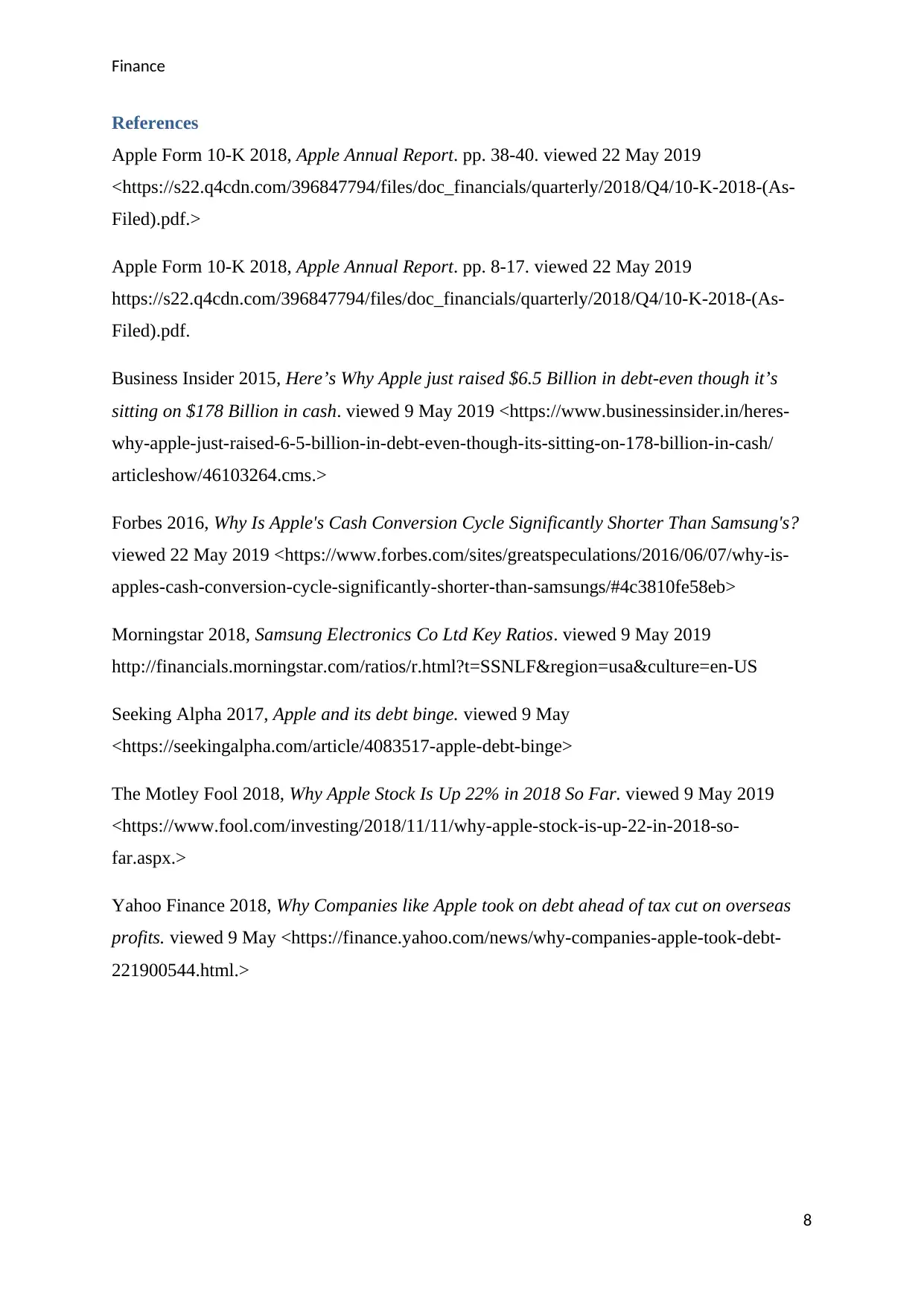
Finance
References
Apple Form 10-K 2018, Apple Annual Report. pp. 38-40. viewed 22 May 2019
<https://s22.q4cdn.com/396847794/files/doc_financials/quarterly/2018/Q4/10-K-2018-(As-
Filed).pdf.>
Apple Form 10-K 2018, Apple Annual Report. pp. 8-17. viewed 22 May 2019
https://s22.q4cdn.com/396847794/files/doc_financials/quarterly/2018/Q4/10-K-2018-(As-
Filed).pdf.
Business Insider 2015, Here’s Why Apple just raised $6.5 Billion in debt-even though it’s
sitting on $178 Billion in cash. viewed 9 May 2019 <https://www.businessinsider.in/heres-
why-apple-just-raised-6-5-billion-in-debt-even-though-its-sitting-on-178-billion-in-cash/
articleshow/46103264.cms.>
Forbes 2016, Why Is Apple's Cash Conversion Cycle Significantly Shorter Than Samsung's?
viewed 22 May 2019 <https://www.forbes.com/sites/greatspeculations/2016/06/07/why-is-
apples-cash-conversion-cycle-significantly-shorter-than-samsungs/#4c3810fe58eb>
Morningstar 2018, Samsung Electronics Co Ltd Key Ratios. viewed 9 May 2019
http://financials.morningstar.com/ratios/r.html?t=SSNLF®ion=usa&culture=en-US
Seeking Alpha 2017, Apple and its debt binge. viewed 9 May
<https://seekingalpha.com/article/4083517-apple-debt-binge>
The Motley Fool 2018, Why Apple Stock Is Up 22% in 2018 So Far. viewed 9 May 2019
<https://www.fool.com/investing/2018/11/11/why-apple-stock-is-up-22-in-2018-so-
far.aspx.>
Yahoo Finance 2018, Why Companies like Apple took on debt ahead of tax cut on overseas
profits. viewed 9 May <https://finance.yahoo.com/news/why-companies-apple-took-debt-
221900544.html.>
8
References
Apple Form 10-K 2018, Apple Annual Report. pp. 38-40. viewed 22 May 2019
<https://s22.q4cdn.com/396847794/files/doc_financials/quarterly/2018/Q4/10-K-2018-(As-
Filed).pdf.>
Apple Form 10-K 2018, Apple Annual Report. pp. 8-17. viewed 22 May 2019
https://s22.q4cdn.com/396847794/files/doc_financials/quarterly/2018/Q4/10-K-2018-(As-
Filed).pdf.
Business Insider 2015, Here’s Why Apple just raised $6.5 Billion in debt-even though it’s
sitting on $178 Billion in cash. viewed 9 May 2019 <https://www.businessinsider.in/heres-
why-apple-just-raised-6-5-billion-in-debt-even-though-its-sitting-on-178-billion-in-cash/
articleshow/46103264.cms.>
Forbes 2016, Why Is Apple's Cash Conversion Cycle Significantly Shorter Than Samsung's?
viewed 22 May 2019 <https://www.forbes.com/sites/greatspeculations/2016/06/07/why-is-
apples-cash-conversion-cycle-significantly-shorter-than-samsungs/#4c3810fe58eb>
Morningstar 2018, Samsung Electronics Co Ltd Key Ratios. viewed 9 May 2019
http://financials.morningstar.com/ratios/r.html?t=SSNLF®ion=usa&culture=en-US
Seeking Alpha 2017, Apple and its debt binge. viewed 9 May
<https://seekingalpha.com/article/4083517-apple-debt-binge>
The Motley Fool 2018, Why Apple Stock Is Up 22% in 2018 So Far. viewed 9 May 2019
<https://www.fool.com/investing/2018/11/11/why-apple-stock-is-up-22-in-2018-so-
far.aspx.>
Yahoo Finance 2018, Why Companies like Apple took on debt ahead of tax cut on overseas
profits. viewed 9 May <https://finance.yahoo.com/news/why-companies-apple-took-debt-
221900544.html.>
8
⊘ This is a preview!⊘
Do you want full access?
Subscribe today to unlock all pages.

Trusted by 1+ million students worldwide

Finance
Appendix
9
Appendix
9
1 out of 10
Related Documents
Your All-in-One AI-Powered Toolkit for Academic Success.
+13062052269
info@desklib.com
Available 24*7 on WhatsApp / Email
![[object Object]](/_next/static/media/star-bottom.7253800d.svg)
Unlock your academic potential
Copyright © 2020–2025 A2Z Services. All Rights Reserved. Developed and managed by ZUCOL.





